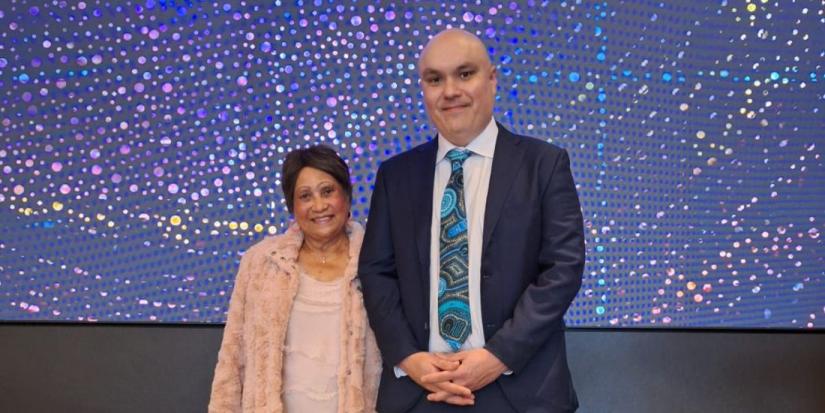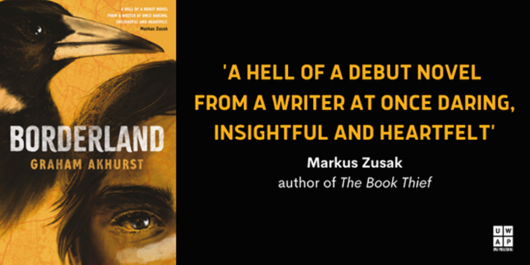We sat down with UTS academic Graham Akhurst to discuss the power of education, reading and the next generation of Indigenous storytelling.

Graham Akhurst and his mum, Gladys at the 2024 National NAIDOC Week awards. Image: supplied.
This year, Graham Akhurst, a Kokomini man, took on the role of Director, Centre for the Advancement of Indigenous Knowledges (CAIK). His incredible work has been recognised in the 2024 National NAIDOC Week awards, where he was a finalist in the Creative Talent Award category. He was in good company with UTS’s Elder-In-Residence, Aunty Glendra Stubbs, a finalist in the Female Elder category, and UTS alum Dr Tui Nolan, who won the Innovation Award.
Graham’s nomination was a nod to the impact of his debut novel, Borderland, a Young Adult story about an Indigenous teen navigating adolescence while discovering what his Indigeneity means to him. While Graham was deeply honoured and proud to be a finalist, he was still riding the high of another massive achievement, becoming a dad to his first son, Oliver. And it’s for Oliver – and all young Indigenous men – that he wrote Borderland.
Growing up, Graham didn’t connect to the Indigenous stories he read. And for good reason – many stories were told by non-Indigenous authors. He struggled to navigate his place in the world and what it meant to be a young Aboriginal man.
Rewriting the narrative
When Graham was 30 and undergoing chemotherapy for Endemic Burkett Lymphoma, he rediscovered his love of reading. It was during this time of delving into Indigenous literature and journaling his experience that he decided to enrol in a creative writing degree. Borderland was a labour of love, grit and navigating spaces that weren’t always culturally safe. The novel itself was 7 years in the making.
When ABC producers came to UTS to film content for the 2024 National NAIDOC Week awards, there was one person Graham knew he wanted to bring along – his mum, Gladys. And she oozed with pride the entire time, ‘When I saw Graham at the book launch in Brisbane, I was just blown away’.
Graham didn’t know much about his mob when he was a teenager growing up off Country. ‘Due to the settler colonial history [of Australia], our history and place was lost. My grandmother was part of the Stolen Generation.’ But his mum – who played the role of mum and dad to Graham and his brother – was at the core of unravelling this disconnect from their culture.
That’s why Graham wants to see more young people reading and writing. ‘There is a deep understanding to be gained from literature,’ he says, and it’s important to him that Indigenous kids see themselves as being reflected in that.
I wrote Borderland for a 15-year-old version of me … If we don’t see it, we don’t believe it.
But Graham believes that literature isn’t just about reflecting on complex issues. He is adamant that writing be a vehicle for young people to experience, ‘A gripping yarn,’ to see how Indigenous stories are an exemplar of culture and humour and getting through extreme trauma.
‘We are the oldest storytellers in the world,’ and that can be a daunting tradition to continue. ‘We’ve been spinning yarns since time immemorial’. Graham is conscious of his role in this space and takes it very seriously, ensuring that he follows cultural protocol and seeks appropriate permissions and guidance where necessary.
Graham wants First Nations literature to receive the recognition it deserves, both in Australia and overseas, so people ‘Can learn of a different lens with which to view the world and experience why we are so resilient’.
With education having been a key driver for Graham, it’s deeply important to him that young Indigenous people have access to learning. ‘Not just from formal education systems and institutions but from our old people too’.
With an ever-growing list of achievements under his belt, Graham now sees finding and advocating for opportunities for young Indigenous writers as one of his most important roles.
Through his role on various boards – the First Nations Australian Writers Network (FNAWN), Varuna: The National Writing House, and The Sydney Review of Books, plus through UTS and CAIK, Graham is focused on creating more opportunities for the next generation of Indigenous storytellers.

Borderland cover art. Image: supplied.
Graham Akhurst is a Kokomini man, the Director of the Centre for the Advancement of Indigenous Knowledges (CAIK) and a Senior Lecturer in Indigenous Studies and Creative Writing.

